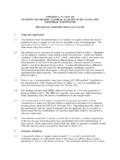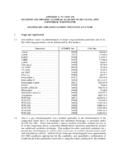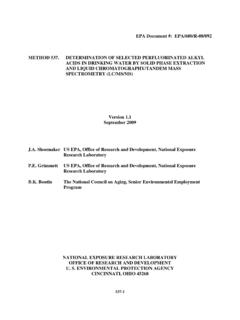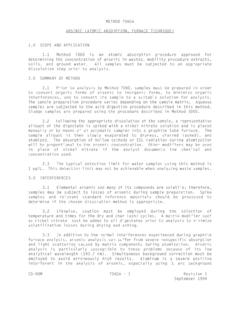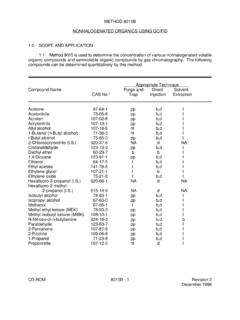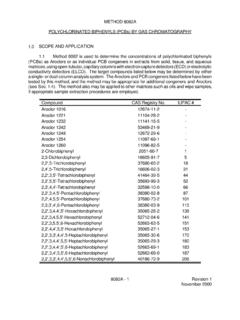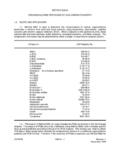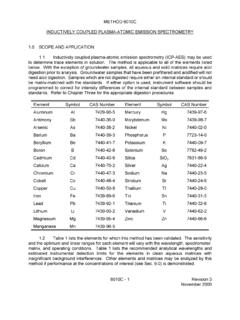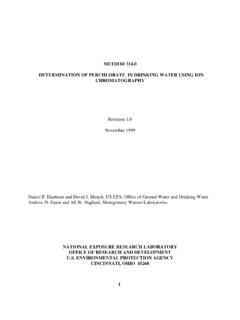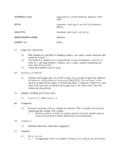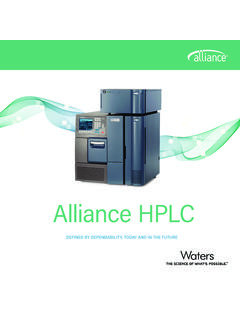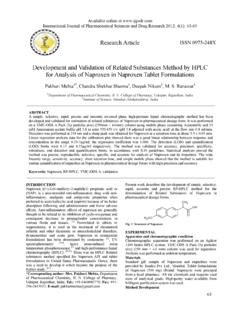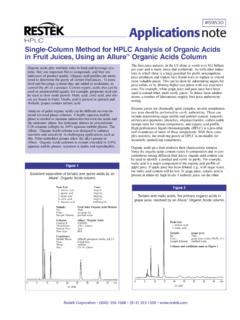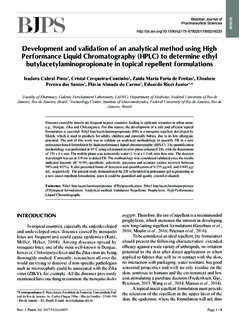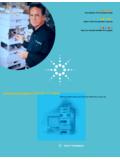Transcription of METHOD 531.1 MEASUREMENT OF N …
1 OF N-METHYLCARBAMOYLOXIMES AND N-METHYL-CARBAMATES IN WATER BY DIRECT AQUEOUS INJECTION hplc WITHPOST COLUMN DERIVATIZATIONR evision by Munch (1995) Foerst - METHOD 531, Revision (1985)T. Engel (Battelle Columbus Laboratories) - National Pesticide SurveyMethod 5, Revision (1987) Graves - METHOD , Revision (1989)NATIONAL EXPOSURE RESEARCH LABORATORYOFFICE OF RESEARCH AND ENVIRONMENTAL PROTECTION AGENCYCINCINNATI, OHIO OF N-METHYLCARBAMOYLOXIMES AND N-METHYL-CARBAMATES IN WATER BY DIRECT AQUEOUS INJECTION hplc WITHPOST COLUMN AND is a high performance liquid chromatographic ( hplc )
2 METHOD applicableto the determinations of certain N-methylcarbamoyloximes andN-methylcarbamates in ground water and finished drinking water. Thefollowing compounds can be determined using this METHOD :AnalyteRegistry NumberChemical Abstract ServicesAldicarb116-06-3 Aldicarb Sulfone1646-88-4 Aldicarb METHOD has been validated in a single laboratory and estimated detectionlimits (EDLs) and METHOD detection limits (MDLS) have been determined forthe analytes above. Observed detection limits may vary between groundwaters, depending upon the nature of interferences in the sample matrix andthe specific instrumentation METHOD is restricted to use by or under the supervision of analystsexperienced in the use of liquid chromatography and in the interpretation ofliquid chromatograms.
3 Each analyst must demonstrate the ability to generateacceptable results with this METHOD using the procedure described inSection this METHOD is used to analyze unfamiliar samples for any or all of theanalytes above, analyte identifications should be confirmed by at least oneadditional qualitative technique . OF water sample is filtered and a 400 L aliquot is injected into a reversephase hplc column. Separation of the analytes is achieved using gradientelution chromatography. After elution from the hplc column, the analytesare hydrolyzed with N sodium hydroxide (NaOH) at 95 C.
4 The methylamine formed during hydrolysis is reacted with o-phthalaldehyde (OPA) and2-mercaptoethanol to form a highly fluorescent derivative which is detected bya fluorescence detector . Analytes are quantitated using procedural standard2calibration (Section ). Standard (IS) -- A pure analyte(s) added to a solution in knownamount(s) and used to measure the relative responses of other methodanalytes and surrogates that are components of the same solution. Theinternal standard must be an analyte that is not a sample Analyte (SA) -- A pure analyte(s), which is extremely unlikely to befound in any sample, and which is added to a sample aliquot in knownamount(s) before extraction and is measured with the same procedures used tomeasure other sample components.
5 The purpose of a surrogate analyte is tomonitor METHOD performance with each Duplicates (LD1 and LD2) -- Two sample aliquots taken in theanalytical laboratory and analyzed separately with identical procedures. Analyses of LD1 and LD2 give a measure of the precision associated withlaboratory procedures, but not with sample collection, preservation, or Duplicates (FD1 and FD2) -- Two separate samples collected at the sametime and place under identical circumstances and treated exactly the samethroughout field and laboratory procedures.
6 Analyses of FD1 and FD2 give ameasure of the precision associated with sample collection, preservation andstorage, as well as with laboratory Reagent Blank (LRB) -- An aliquot of reagent water that is treatedexactly as a sample including exposure to all glassware, equipment, solvents,reagents, internal standards, and surrogates that are used with other samples. The LRB is used to determine if METHOD analytes or other interferences arepresent in the laboratory environment, the reagents, or the Reagent Blank (FRB) -- Reagent water placed in a sample container in thelaboratory and treated as a sample in all respects, including exposure tosampling site conditions, storage, preservation and all analytical procedures.
7 The purpose of the FRB is to determine if METHOD analytes or otherinterferences are present in the field Performance Check Solution (LPC) -- A solution of methodanalytes, surrogate compounds, and internal standards used to evaluate theperformance of the instrument system with respect to a defined set of Fortified Blank (LFB) -- An aliquot of reagent water to whichknown quantities of the METHOD analytes are added in the laboratory. The LFBis analyzed exactly like a sample, and its purpose is to determine whether themethodology is in control, and whether the laboratory is capable of makingaccurate and precise measurements at the required METHOD detection Fortified Sample Matrix (LFM) -- An aliquot of an environmentalsample to which known quantities of the METHOD analytes are added in thelaboratory.
8 The LFM is analyzed exactly like a sample, and its purpose is todetermine whether the sample matrix contributes bias to the analytical results. The background concentrations of the analytes in the sample matrix must bedetermined in a separate aliquot and the measured values in the LFMcorrected for background Standard Solution (SSS) -- A concentrated solution containing a singlecertified standard that is a METHOD analyte, or a concentrated solution of asingle analyte prepared in the laboratory with an assayed reference compound.
9 Stock standard solutions are used to prepare primary dilution Dilution Standard Solution (PDS) -- A solution of several analytesprepared in the laboratory from stock standard solutions and diluted asneeded to prepare calibration solutions and other needed analyte Standard (CAL) -- A solution prepared from the primary dilutionstandard solution and stock standard solutions of the internal standards andsurrogate analytes. The CAL solutions are used to calibrate the instrumentresponse with respect to analyte Control Sample (QCS) -- A sample matrix containing METHOD analytesor a solution of METHOD analytes in a water miscible solvent which is used tofortify reagent water or environmental samples.
10 The QCS is obtained from asource external to the laboratory, and is used to check laboratory performancewith externally prepared test Standard Calibration -- A calibration METHOD where aqueouscalibration standards are prepared and processed ( , purged, extracted,and/or derivatized) in exactly the same manner as a sample. All steps in theprocess from addition of sampling preservatives through instrumental analysesare included in the calibration. Using procedural standard calibrationcompensates for any inefficiencies in the processing interferences may be caused by contaminants in solvents, reagents,glassware and other sample processing apparatus that lead to discrete artifactsor elevated baselines in liquid chromatograms.
